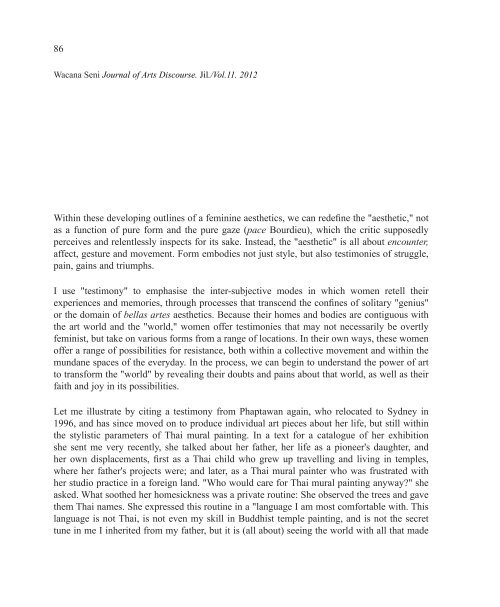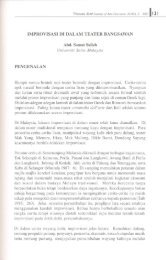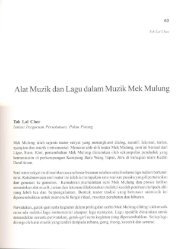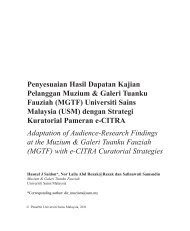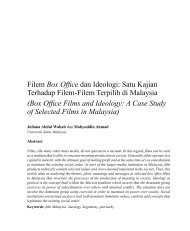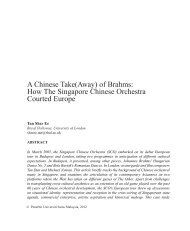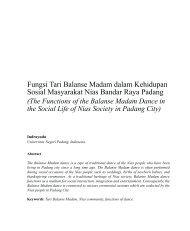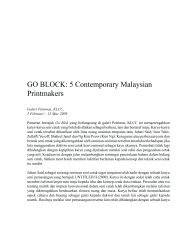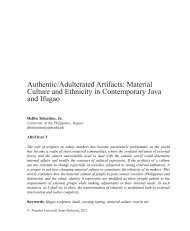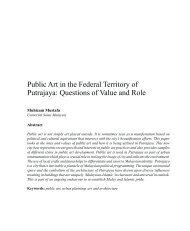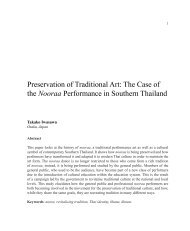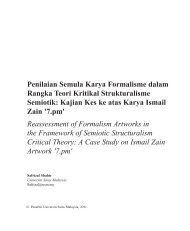Reclaiming The Healing Arts of The Ancient ... - Wacana Seni
Reclaiming The Healing Arts of The Ancient ... - Wacana Seni
Reclaiming The Healing Arts of The Ancient ... - Wacana Seni
Create successful ePaper yourself
Turn your PDF publications into a flip-book with our unique Google optimized e-Paper software.
86<strong>Wacana</strong> <strong>Seni</strong> Journal <strong>of</strong> <strong>Arts</strong> Discourse. Jil./Vol.11. 2012Within these developing outlines <strong>of</strong> a feminine aesthetics, we can redefine the "aesthetic," notas a function <strong>of</strong> pure form and the pure gaze (pace Bourdieu), which the critic supposedlyperceives and relentlessly inspects for its sake. Instead, the "aesthetic" is all about encounter,affect, gesture and movement. Form embodies not just style, but also testimonies <strong>of</strong> struggle,pain, gains and triumphs.I use "testimony" to emphasise the inter-subjective modes in which women retell theirexperiences and memories, through processes that transcend the confines <strong>of</strong> solitary "genius"or the domain <strong>of</strong> bellas artes aesthetics. Because their homes and bodies are contiguous withthe art world and the "world," women <strong>of</strong>fer testimonies that may not necessarily be overtlyfeminist, but take on various forms from a range <strong>of</strong> locations. In their own ways, these women<strong>of</strong>fer a range <strong>of</strong> possibilities for resistance, both within a collective movement and within themundane spaces <strong>of</strong> the everyday. In the process, we can begin to understand the power <strong>of</strong> artto transform the "world" by revealing their doubts and pains about that world, as well as theirfaith and joy in its possibilities.Let me illustrate by citing a testimony from Phaptawan again, who relocated to Sydney in1996, and has since moved on to produce individual art pieces about her life, but still withinthe stylistic parameters <strong>of</strong> Thai mural painting. In a text for a catalogue <strong>of</strong> her exhibitionshe sent me very recently, she talked about her father, her life as a pioneer's daughter, andher own displacements, first as a Thai child who grew up travelling and living in temples,where her father's projects were; and later, as a Thai mural painter who was frustrated withher studio practice in a foreign land. "Who would care for Thai mural painting anyway?" sheasked. What soothed her homesickness was a private routine: She observed the trees and gavethem Thai names. She expressed this routine in a "language I am most comfortable with. Thislanguage is not Thai, is not even my skill in Buddhist temple painting, and is not the secrettune in me I inherited from my father, but it is (all about) seeing the world with all that made


